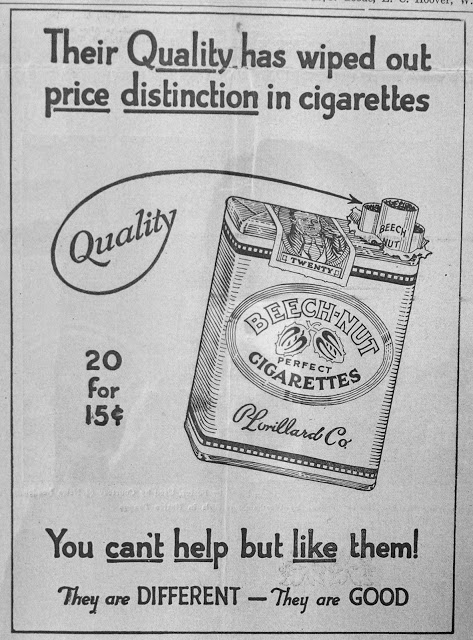The Richmond Collegian, the student newspaper from the University of Richmond, provides a unique opportunity to look at state of the art advertising from the major tobacco companies of the period. The advertising was likely influenced by the groundbreaking work of Edward Bernays who published Propaganda in 1928. Here’s an excellent BBC documentary called The Century of the Self which looks at the significant influence Bernays exerted in the fields of advertising and public relations.
The Collegian is unique in my experience for it’s large, half page and 3/4 page size, tobacco advertisements. No other businesses took out so many advertisements nor on such a grand scale. As I was taking photos for this blog, I realized this should be a series of blog posts to do justice to the subject. I was surprised to realize that the advertisements were elaborate campaigns, series of related ads that followed a theme.

It is easy to imagine a Madison Avenue advertising agency pitching these campaigns to tobacco company marketers and management.
From Richmond Collegian, Dec. 2, 1921. This early tobacco ad is typical of early twentieth century advertisements. There are no deep psychological appeals. The message is simply, we have a good cigarette, you should buy it. The advertisement also included the retail price which later ads did not include.
Part 1 : Cellophane and Celebrities
The cellophane wrapper to help keep cigarettes fresh was introduced in the early 1930s. Both Camel and Lucky Strike boasted of their new cellophane wrappers, both companies referred to the wrapper as a “humidor pack.”
Lucky Strike lead the effort to popularize smoking among women, mostly famously by the “Torches of Freedom” campaign carried out by Edward Bernays. Women were organized to smoke cigarettes during the 1929 Easter parade in New York City. In the advert below, they appeal to women specifically, “Ladies — the LUCKY TAG is — your finger nail protection.” This advert also included a photo and comments by Ina Clair, a stage and movie actress of the period.
The above ad carried the famous slogan, “It’s Toasted” which Lucky Strike had used since 1917. The reason given here for toasting is “throat protection.” The ad claims, “… the exclusive “TOASTING” Process which includes the use of modern Ultra Violet Rays — the process that expels certain harsh, biting irritants naturally present in every tobacco leaf.”
On the other hand Camel claimed, “Camels are never parched or toasted.” “We would never dream of parching or toasting these choice sun-ripened tobaccos–that would only drive off or destroy the natural moisture that makes Camels fresh in nature’s own mild way.” The ad closes with a challenge and an ominous warning, “… switch to Camels for just one day — then leave them, if you can.”
A mainstay in the advertising of Lucky Strike was celebrity endorsements. Here are several.
The other major cigarette brand to advertise in the newspaper was Chesterfield. The selling points of Chesterfield were that they were milder, tasted better, purity (one ad claimed they were “pure as the water you drink”), and they satisfy. This mantra was repeated again and again, every week with a different photo and a variation on the text.
I particularly like the two ads below, with a couple painted in chiaroscuro, glowing in the match light. How romantic!
Pipe tobacco was also advertised but not so heavily. The two chief pipe tobacco brands advertised were Granger, owned by Liggett & Myers Tobacco Company which also owned Chesterfields, and Edgeworth, owned by Larus & Bro. Company from Richmond, Virginia.
Edgeworth’s advertisements mostly contained the same photo but the text varied from week to week. The sentiment of most was that smoking a pipe was something for “real he-men” and that smoking was “part of a college education.”
The advertisements for Granger walk an unusual line, many show a man and a woman. The women say things like: “You like that old pipe don’t you?” and “I like to watch you smoking your pipe!” and “I believe you love that old pipe better than you do me!” A jealous and admiring woman who knows her place in relation to the pipe. While cigarettes companies during this period were seeking to build up female consumers, pipe tobaccos seemed content exclusively appealing to men.










































Looking for a person who did ads or worked on ads for Chesterfield Cigarettes… in New York in 1935 or abt then. Roger Reynolds is the name, he is supposed to have been born in Glasgow, Scotland..I am/have been looking for a needle in a haystack since 1952..If you can help, thank you for any information. If not, thank you for reading my query..
very enlightened and informative blog.
very nice and informative keep it up
Informative Post. Thank you for sharing.
Thanks for sharing informative article.
Your article is very much valuable as it describe the marketing in the previous century. It also tells us that people in the past also focus the packaging and marketing of the products.
The content you have shared is of great value. No one can undermine the importance of cigarette packaging as it had a great impact on customers.